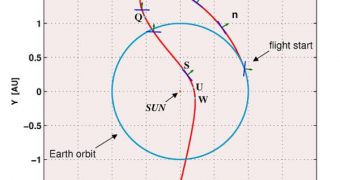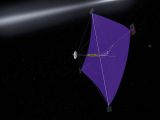The concept of solar sails, devices that would rely on solar winds and photons to power up spacecraft traveling through the solar system and beyond, has been around for quite some time now. Although some of the materials theoretically needed for them have been developed, and even a few not-that-successful attempts have been made to launch solar sail-powered devices, the technology is still considered to be some time away from mass implementation. Now, astronomers are beginning to realize that they are still short on basic knowledge of future spaceships, such as how to navigate them.
Theoretically speaking, a space probe weighing in at 150 kilograms, attached to a solar sail with a radius of about a kilometer and a mass of 150 kilograms, could move through the solar system in no time. If it is deployed in orbit at about 0.1AU (astronomical units) away from the Sun, where the solar wind pressure is higher, and set on a parabolic trajectory, then it could accelerate by as much as 0.6G. With such an acceleration, the craft would reach the Kuiper belt, located some 200 AU away, in just 2.5 years.
An astronomical unit is a measure of distance, equal to the average distance between the Sun and the Earth. Therefore, the theory implies that a spaceship needs to be launched very close to the star, in order to benefit from the full advantages of massive amounts of radiation pressure, which could send it to the Oort Cloud, some 2,500 AU away, in under 30 years. This is a time duration that space agencies could consider feasible, experts say. In short, implementing space sail technologies would undoubtedly open up new frontiers for space exploration.
But one of the main problems that a future solar sail-powered spacecraft is most likely to have resides in its controls. The probe will not be able to steer its sails like a boat does in the ocean, and will have to be set on the correct trajectory from the start. The smallest variations could lead, in a 2,500 AU-long journey, to errors of up to a million miles, which are naturally to be avoided. Experts believe that, with it being launched so close to the Sun, the spacecraft's orbital planners will have to keep in mind the theory of general relativity, as well as the precession of the perihelion of orbiting objects.
City University of New York physicists Roman Kezerashvili and Justin Vazquez-Poritz say that the engineers who plan the first few flights of solar sail-powered spacecraft would have to become proficient in the newly developed field of relativistic navigation beforehand. However, with the first such flight scheduled to take place no earlier than 2040, there is still sufficient time to learn, Technology Review informs.

 14 DAY TRIAL //
14 DAY TRIAL // 
